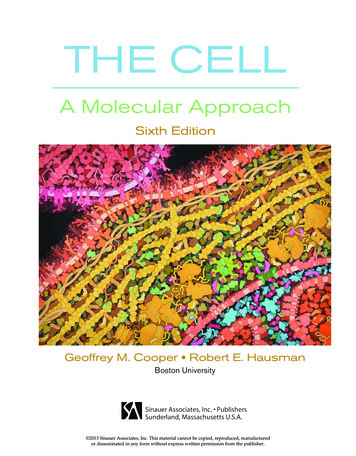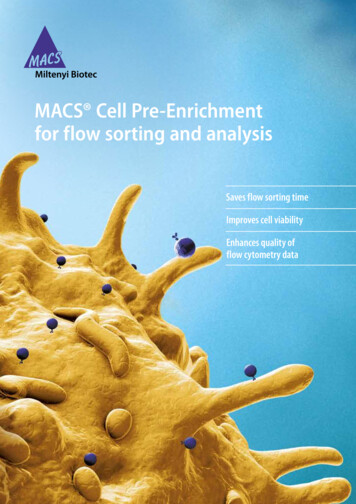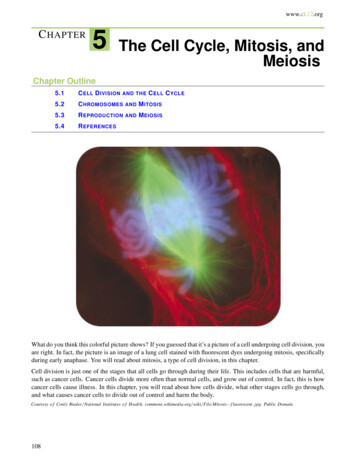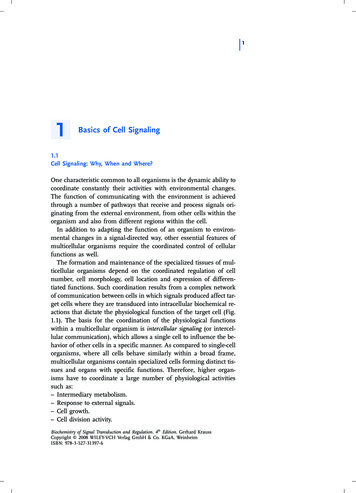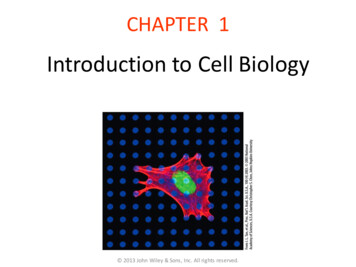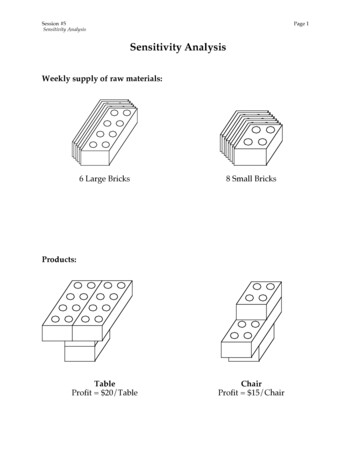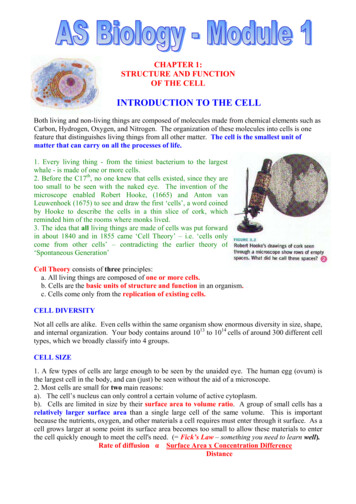
Transcription
CHAPTER 1:STRUCTURE AND FUNCTIONOF THE CELLINTRODUCTION TO THE CELLBoth living and non-living things are composed of molecules made from chemical elements such asCarbon, Hydrogen, Oxygen, and Nitrogen. The organization of these molecules into cells is onefeature that distinguishes living things from all other matter. The cell is the smallest unit ofmatter that can carry on all the processes of life.1. Every living thing - from the tiniest bacterium to the largestwhale - is made of one or more cells.2. Before the C17th, no one knew that cells existed, since they aretoo small to be seen with the naked eye. The invention of themicroscope enabled Robert Hooke, (1665) and Anton vanLeuwenhoek (1675) to see and draw the first ‘cells’, a word coinedby Hooke to describe the cells in a thin slice of cork, whichreminded him of the rooms where monks lived.3. The idea that all living things are made of cells was put forwardin about 1840 and in 1855 came ‘Cell Theory’ – i.e. ‘cells onlycome from other cells’ – contradicting the earlier theory of‘Spontaneous Generation’Cell Theory consists of three principles:a. All living things are composed of one or more cells.b. Cells are the basic units of structure and function in an organism.c. Cells come only from the replication of existing cells.CELL DIVERSITYNot all cells are alike. Even cells within the same organism show enormous diversity in size, shape,and internal organization. Your body contains around 1013 to 1014 cells of around 300 different celltypes, which we broadly classify into 4 groups.CELL SIZE1. A few types of cells are large enough to be seen by the unaided eye. The human egg (ovum) isthe largest cell in the body, and can (just) be seen without the aid of a microscope.2. Most cells are small for two main reasons:a). The cell’s nucleus can only control a certain volume of active cytoplasm.b). Cells are limited in size by their surface area to volume ratio. A group of small cells has arelatively larger surface area than a single large cell of the same volume. This is importantbecause the nutrients, oxygen, and other materials a cell requires must enter through it surface. As acell grows larger at some point its surface area becomes too small to allow these materials to enterthe cell quickly enough to meet the cell's need. ( Fick’s Law – something you need to learn well).Rate of diffusion α Surface Area x Concentration DifferenceDistance
CELL SHAPECells come in a variety of shapes – depending on their function:The neurones from your toes to your head are long and thin;Blood cells are rounded disks, so that they can flow smoothly.INTERNAL ORGANIZATION1. Cells contain a variety of internal structures called organelles.2. An organelle is a cell component thatperforms a specific function in that cell.3. Just as the organs of a multicellular organismcarry out the organism's life functions, theorganelles of a cell maintain the life of the cell.4. There are many different cells; however,there are certain features common to all cells.5. The entire cell is surrounded by a thin cellmembrane. All membranes have the samethickness and basic structure.6. Organelles often have their own membranestoo – once again, these membranes have a similar structure.7. The nucleus, mitochondria and chloroplasts all have double membranes, more correctlycalled envelopes.8. Because membranes are fluid mosaics, the molecules making them up – phospholipids andproteins - move independently. The proteins appear to ‘float’ in the phospholipids bilayer and thusmembranes can thus be used to transport molecules within the cell e.g. endoplasmic reticulum.9. Proteins in the membrane can be used to transport substances across the membrane – e.g. byfacilitated diffusion or by active transport.10. The proteins on the outside of cell membranes identify us as unique.
Prokaryotes v. EukaryotesOrganisms whose cells normally contain a nucleus are called Eukaryotes; those (generally smaller)organisms whose cells lack a nucleus and have no membrane-bound organelles are known asProkaryotes.A Prokaryotic cell (bacterium)A Eukaryotic cell (plant)ProkaryotesTypical organismsEukaryotesbacteriaProtoctista, fungi, plants, animals 1-10 µm 10-100 µm (sperm cells) apart from the tail, aresmaller)Nuclear bodyNo nucleusreal nucleus with nuclear envelopecircular (ccc DNA)linear molecules (chromosomes) with histoneproteins70S80SCytoplasmaticstructurevery few structureshighly structured by membranes and a cytoskeletonCell movementFlagellae/cilia made offlagellinflagellae and cilia made of tubulinMitochondrianone1 - 100 (though RBC’s have none)Chloroplastsnonein algae and plantsOrganizationusually single cellssingle cells, colonies, higher multicellularorganisms with specialized cellsCell divisionBinary fission(simple division)Mitosis (normal cell replication)Meiosis (gamete production)Typical sizeType of nucleusDNARibosomes
PARTS OF THE EUKARYOTIC CELLThe structures that make up a Eukaryotic cell are determined by the specific functions carried outby the cell. Thus, there is no typical Eukaryotic cell. Nevertheless, Eukaryotic cells generally havethree main components: A cell membrane, a nucleus, and a variety of other organelles.THE CELL MEMBRANE1. A cell cannot survive if it is totally isolated from its environment. The cell membrane is acomplex barrier separating every cell from its external environment.2. This "Selectively Permeable" membrane regulates what passes into and out of the cell.3. The cell membrane is a fluid mosaic of proteins floating in a phospholipid bilayer.4. The cell membrane functions like a gate,controlling which molecules can enter and leavethe cell.5. The cell membrane controls which substancespass into and out of the cell. Carrier proteins inor on the membrane are specific, only allowing asmall group of very similar molecules through.For instance, α- glucose is able to enter; but β –glucose is not. Many molecules cannot cross atall. For this reason, the cell membrane is said to beselectively permeable.6. The rest of the cell membrane is mostly composed of phospholipid molecules. They have onlytwo fatty acid ‘tails’ as one has been replaced by a phosphate group (making the ‘head’)7. The head is charged and so polar; the tails are not chargedand so are non-polar. Thus the two ends of the phospholipidmolecule have different properties in water. The phosphatehead is hydrophyllic and so the head will orient itself so that itis as close as possible to water molecules. The fatty acid tailsare hydrophobic and so will tend to orient themselves awayfrom water.8. So, when in water, phospholipids line up on the surfacewith their phosphate heads sticking into the water and fatty acidtails pointing up from the surface.9. Cells are bathed in an aqueous environment and since theinside of a cell is also aqueous, both sides of the cell membraneare surrounded by water molecules.10. This causes the phospholipids of the cell membrane to formtwo layers, known as a phospholipid bilayer. In this, the heads face the watery fluids inside andoutside the cell, whilst the fatty acid tails are sandwiched inside the bilayer.11. The cell membrane is constantly being formed and broken down in living cells.CYTOPLASM1. Everything within the cell membrane which is not the nucleus is knownas the cytoplasm.2. Cytosol is the jelly-like mixture in which the other organelles aresuspended, so cytosol organelles cytoplasm.3. Organelles carry out specific functions within the cell. In Eukaryoticcells, most organelles are surrounded by a membrane, but in Prokaryoticcells there are no membrane-bound organelles.
FLUID MOSAIC MODEL OF CELL MEMBRANES1. Membranes are fluid and are rather viscous –like vegetable oil.2. The molecules of the cell membrane are alwaysin motion, so the phospholipids are able to driftacross the membrane, changing places with theirneighbour.3. Proteins, both in and on the membrane, form amosaic, floating in amongst the phospholipids.4. Because of this, scientists call the modern viewof membrane structure the ‘Fluid Mosaic Model’.6. The mosaic of proteins in the cell membrane is constantly changing.MEMBRANE PROTEINS1. A variety of protein molecules are embedded in the basicphospholipid bilayer.2. Some proteins are attached to the surface of the cellmembrane on both the internal and external surface. Thesemay be hormone receptors, enzymes or cell recognitionproteins (or antigens)3. Other proteins are embedded in the phospholipid bilayeritself. These are often associated with transporting moleculesfrom one side of the membrane to the other and are referredto as carrier proteins.4. Some of these form channels or pores through whichcertain substances can pass (facilitated diffusion), whilst others bind to a substance on one side ofthe membrane and carry it to the other side of the membrane (active transport)5. Proteins exposed to the cell's external environment often have carbohydrates attached to themwhich act as antigens (e.g. blood groups A & B – group AB has both; group O has neither).6. Some viruses may also bind here too.THE NUCLEUS (pl. NUCLEI)1. The nucleus is normally the largest organelle within a Eukaryotic cell. But it is NOT the ‘brain’of the cell!!2. Prokaryotes have no nucleus, having a nuclear body instead. This has no membrane and aloop of DNA - cccDNA - and no chromatin proteins)3. The nucleus contains the cell’s chromosomes (human, 46, fruit fly 6, fern 1260) which arenormally uncoiled to form a chromatinic network, which containboth linear DNA and proteins, known as histones. These proteinscoil up (dehydrate) at the start of nuclear division, when thechromosomes first become visible.4. Whilst most cells have a single nucleus some cells (macrophages,phloem companion cells) have more than one and fungi have manynuclei in their cytoplasm – they are coenocytic ( commoncytoplasm throughout)5. The nucleus is surrounded by a double membrane called thenuclear envelope, which has many nuclear pores through whichmRNA, and proteins can pass. These dimples make it look like a golf ball.6. Most nuclei contain at least one nucleolus (plural, nucleoli). The nucleoli are where ribosomesare synthesised. Ribosomes, you remember, translate mRNA into proteins.7. When a nucleus prepares to divide, the nucleolus disappears.
An animal cellA plant cellComparison of structures between animal and plant cellsTypical animal cellOrganelles Additionalstructures Nucleuso Nucleolus (within nucleus)Rough ERSmooth ER80S RibosomesCytoskeletonGolgi somesCentriolesCiliaFlagellaePlasma membraneTypical plant cell Nucleuso Nucleolus (within nucleus)Rough ERSmooth ER80S RibosomesCytoskeletonGolgi apparatusCytoplasmMitochondrionVesicleChloroplast and other plastidsCentral vacuoleo Tonoplast(central vacuole membrane)Plasma membraneCellulose cell wallPlasmodesmata
MITOCHONDRIA1. Mitochondria are found scattered throughout thecytosol, and are relatively large organelles (secondonly to the nucleus and chloroplasts).2. Mitochondria are the sites of aerobic respiration, inwhich energy from organic compounds is transferredto ATP. For this reason they are sometimes referredto as the ‘powerhouse’ of the cell.3. ATP is the molecule that most cells use as theirmain energy ‘currency’.4. Mitochondria are more numerous in cells that have a high energy requirement - our muscle cellscontain a large number of mitochondria, as do liver, heart and sperm cells.5. Mitochondria are surrounded by two membranes, indicating that they were once free-livingorganisms that have become mutualistic and then a part of almost every eukaryotic cell (not RBC’sand xylem vessels)A. The smooth outer membrane serves as a boundary between the mitochondria and the cytosol.B. The inner membrane has many long folds, known as cristae, which greatly increase thesurface area of the inner membrane, providing more space for ATP synthesis to occur.6. Mitochondria have their own DNA, and new mitochondria arise only when existing ones growand divide. They are thus semi-autonomous organelles.RIBOSOMES1. Unlike most other organelles, ribosomes are not surrounded by a membrane.2. Ribosomes are the site of protein synthesis in a cell.3. They are the most common organelles in almost all cells.4. Some are free in the cytoplasm (Prokaryotes); others line the membranes ofrough endoplasmic reticulum (rough ER).5. They exist in two sizes:70s are found in all Prokaryotes, chloroplasts and mitochondria,suggesting that they have evolved from ancestral Prokaryotic organisms.They are free-floating.80s found in all eukaryotic cells – attached to the rough ER (they are rather larger).6. Groups of 80s ribosomes, working together, are known as a polysome.ENDOPLASMIC RETICULUM (ER)1. The ER is a system of membranous tubules and sacs.2. The primary function of the ER is to act as an internal transport system, allowing molecules tomove from one part of the cell to another.3. The quantity of ER inside a cell fluctuates, depending on the cell'sactivity. Cells with a lot include secretory cells and liver cells.4. The rough ER is studded with 80s ribosomes and is the site ofprotein synthesis. It is an extension of the outer membrane ofthenuclear envelope, so allowing mRNA to be transported swiftly to the80s ribosomes, where they are translated in protein synthesis.5. The smooth ER is where polypeptides are converted intofunctional proteins and where proteins are prepared for secretion. It isalso the site of lipid and steroid synthesis, and is associated with theGolgi apparatus. Smooth ER has no 80s ribosomes and is alsoinvolved in the regulation of calcium levels in muscle cells, and thebreakdown of toxins by liver cells.6. Both types of ER transport materials throughout the cell.
GOLGI APPARATUS1. The Golgi apparatus is the processing, packaging and secreting organelle ofthe cell, so it is much more common in glandular cells.2. The Golgi apparatus is a system of membranes, made of flattened sac-likestructures called cisternae.3. It works closely with the smooth er, to modify proteins for export by the cell.LYSOSOMES1. Lysosomes are small spherical organelles that enclose hydrolytic enzymes within a singlemembrane.2. Lysosomes are the site of protein digestion – thus allowing enzymes to be re-cycled when theyare no longer required. They are also the site of food digestion in the cell, and of bacterial digestionin phagocytes.3. Lysosomes are formed from pieces of the Golgi apparatus that break off.4. Lysosomes are common in the cells of Animals, Protoctista and even Fungi, but rare in plants.CYTOSKELETON1. Just as your body depends on your skeleton to maintain its shape and size, so a cell needsstructures to maintain its shape and size.2. In animal cells, which have no cell wall, an internal framework called the cytoskeleton maintainsthe shape of the cell, and helps the cell to move.3. The cytoskeleton consists of two structures:a) microfilaments (contractile). They are made of actin, and are common in motile cells.b) microtubules (rigid, hollow tubes – made of tubulin).4. Microtubules have three functions:a. To maintain the shape of the cell.b. To serve as tracks for organelles to move along within the cell.c. They form the centriole.CENTRIOLE1. This consists of two bundles of microtubules at right-angles to eachother.2. Each bundle contains 9 tubes in a very characteristic arrangement3. At the start of mitosis and meiosis, the centriole divides, and onehalf moves to each end of the cell, forming the spindle.4. The spindle fibres are later shortened to pull the chromosomesapart.CILIA AND FLAGELLAE1. Cilia and Flagellae are structures that project from the cell, where they assist in movement.2. Cilia (sing. cilium) are short, and numerous and hair-like.3. Flagellae (sing. flagellum) are much longer, fewer, and are whip-like.4. The cilia and flagellae of all Eukaryotes are always in a ‘9 2’arrangement that is characteristic (see diagram).5. Protoctista commonly use cilia and flagellae to move through water.6. Sperm use flagellae (many, all fused together) to swim to the egg.7. Cilia line our trachea and bronchi, moving dust particles and bacteria awayfrom the lungs.
PLANT CELL STRUCTURES1. Most of the organelles and other parts of the cell are common to all Eukaryotic cells. Cells fromdifferent organisms have an even greater difference in structure.2. Plant cells have three additional structures not found in animal cells: Cellulose cell walls Chloroplasts (and other plastids) A central vacuole.CELLULOSE CELL WALL1. One of the most important features of all plants is presence of a cellulose cell wall.2. Fungi such as Mushrooms and Yeast also have cell walls, but these are made of chitin.3. The cell wall is freely permeable (porous), and so has no direct effect on the movement ofmolecules into or out of the cell.4. The rigidity of their cell walls helps both to support and protect the plant.5. Plant cell walls are of two types:a). Primary (cellulose) cell wall - While a plant cell is being formed, a middle lamella made ofpectin, is formed and the cellulose cell wall develops between the middle lamella and thecell membrane. As the cell expands in length, more cellulose is added, enlarging the cellwall. When the cell reaches full size, a secondary cell wall may form.b). Secondary (lignified) cell wall - The secondary cell wall is formed only in woody tissue(mainly xylem). The secondary cell wall is stronger and waterproof and once a secondary cell wallforms, a cell can grow no more – it is dead!VACUOLES1. The most prominent structure in plant cells is the large vacuole.2. The vacuole is a large membrane-bound sac that fills up much of most plant cells.3. The vacuole serves as a storage area, and may contain stored organic molecules as well asinorganic ions.4. The vacuole is also used to store waste. Since plants have no kidney, they convert waste to aninsoluble form and then store it in their vacuole - until autumn!5. The vacuoles of some plants contain poisons (eg tannins) that discourage animals from eatingtheir tissues.6. Whilst the cells of other organisms may also contain vacuoles, they are much smaller and areusually involved in food digestion.CHLOROPLASTS (and other plastids)1. A characteristic feature of plant cells is the presence of plastids that make or store food.2. The most common of these (some leaf cells only!) arechloroplasts – the site of photosynthesis.3. Each chloroplast encloses a system of flattened,membranous sacs called thylakoids, which containchlorophyll.4. The thylakoids are arranged in stacks called grana.5. The space between the grana is filled with cytoplasmlike stroma.6. Chloroplasts contain ccc DNA and 70S ribosomes andare semi-autonomous organelles.7. Other plastids store reddish-orange pigments that colourpetals, fruits, and some leaves.
MULTICELLULAR ORGANIZATIONIn a unicellular organism, one cell carries out all of the functions of life. In contrast, most cells in amulticellular organism are specialized to perform one or a few functions – more efficiently.Because of cell specialization, the cells of multicellular organisms depend on other cells in theorganism for their survival.TISSUE, ORGANS, AND ORGAN SYSTEMS1. In most Multicellular Organisms, we find the following organization:Cellular Level: The smallest unit of life capable of carrying out all the functions of livingthings.Tissue Level: A group of cells that performs a specific function in an organism.Organ Level: Several different types of tissue that function together for a specific purpose.Organ System Level: Several organs working together to perform a function. Thedifferent organ systems in a multicellular organism interact to carry out the processes of life2. Plants also have tissue and organs, although they are arranged somewhat differently from thoseof animals – e.g. vascular tissue.3. The four plant organs are:RootsStemsLeaves andFlowersCOLONIAL ORGANIZATIONS1. A colonial organization is a collection of genetically identical cells that live together in a closelyconnected group.2. Many of the cells of the colony carry out specific functions that benefit the whole colony.3. Colonial organisms (e.g. sponges, coral) appear to straddle the border between a collection ofunicellular organisms and a true multicellular organism. They lack tissues and organs, but doexhibit the principle of cell specialization.
ORGANELLE LOCATIONDESCRIPTIONouter layerrigid, strong, stiffmade of celluloseFUNCTIONcell wallplant, not animalcell membraneboth plant/animal plant - inside cell wallanimal - outer layer;cholesterolselectively permeablesupportprotectioncontrols movement ofmaterials in/out of cellbarrier between cell andits environmentmaintains homeostasisnucleusnuclearmembraneboth plant/animal large, ovalcontrols cell activitiesboth plant/animal surrounds nucleusselectively permeableControls movement ofmaterials in/out ofnucleuscytoplasmboth plant/animal clear, thick, jellylike material supports /protects celland organelles found insideorganellescell membraneboth plant/animal network of tubes orendoplasmicmembranesreticulum (E.R.)both plant/animal small bodies free or attachedribosomesupport (grow tall)protectionallows H2O, O2, CO2 topass into and out of cellcarries materials throughcellproduces proteinsto E.R.mitochondrionboth plant/animal bean-shaped with innermembranesbreaks down sugarmolecules into energyvacuoleplant - few/largeanimal - smallstore food, water, waste(plants need to store largeamounts of food)lysosomeplant small, round, with auncommonmembraneanimal - commonchloroplastplant, not animalfluid-filled sacsbreaks down larger foodmolecules into smallermoleculesdigests old cell partsgreen, oval usually containing uses energy from sun tochlorophyll (green pigment)make food for the plant(photosynthesis) IHW September 2005
1. A cell cannot survive if it is totally isolated from its environment. The cell membrane is a complex barrier separating every cell from its external environment. 2. This "Selectively Permeable" membrane regulates what passes into and out of the cell. 3. The cell membrane is a fluid mosaic of proteins floating in a phospholipid bilayer. 4.

